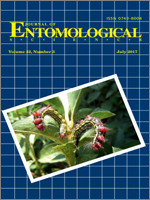Japanese beetles, Popillia japonica Newman, are nursery regulatory pests. Currently, immersion of balled-and-burlapped (B&B) and containerized plants grown in pine bark substrates in a chlorpyrifos or bifenthrin solution satisfies the Domestic Japanese Beetle Harmonization Plan (DJHP) for shipping plants to noninfested states. Study objectives were to (a) evaluate individual and combination insecticide treatments for potential as regulatory dips against third-instar P. japonica in 30-cm B&B and no. 3 containers and (b) determine the lowest effective rates. Tests were performed fall and spring from 2007 to 2010. In all B&B tests and most container tests, insecticide treatments had significantly fewer larvae than the untreated check. Treatments also were more effective during spring tests than fall tests. The highest rate of a bifenthrin imidacloprid combination was the only treatment that consistently met the DJHP regulatory standard of no larvae recovered across multiple tests. During spring tests with B&B and container plants, all rates tested of bifenthrin, bifenthrin carbaryl, chlorantraniliprole, clothianidin, or dinotefuran met the no-larval-recovery DJHP standard. The lowest effective bifenthrin rate during spring tests was 9× lower than the current DJHP bifenthrin dip rate. Several treatments in this study met DJHP regulatory standards for dipping B&B and containerized plants and during spring timings bifenthrin alone or in combination with carbaryl or imidacloprid was effective at rates lower than currently allowed in the DJHP.
How to translate text using browser tools
1 July 2017
Insecticides and Their Combinations Evaluated as Regulatory Immersion Treatments for Third-Instar Japanese Beetle (Coleoptera: Scarabaeidae) in Field-Grown and Containerized Nursery Plants
J.B. Oliver,
C.M. Ranger,
M.E. Reding,
N.N. Youssef,
J.J. Moyseenko
ACCESS THE FULL ARTICLE

Journal of Entomological Science
Vol. 52 • No. 3
July 2017
Vol. 52 • No. 3
July 2017
insecticide
nursery
plant dip
Popillia japonica
scarab




